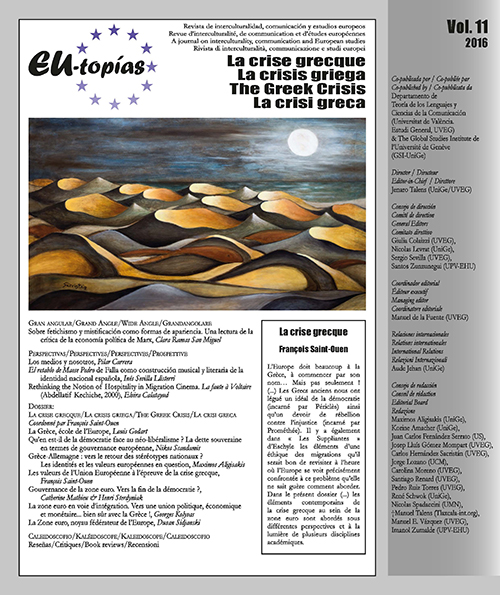The Media and Us
DOI:
https://doi.org/10.7203/eutopias.0.18669Keywords:
Internet, mass media, culture, rhetoric, ideology Abstract
Abstract
Internet has created a system of mediations orphan of a specific hardware. We connect to the Internet via our computer, mobile phone, tablet, watch, glasses, our TV set… The interstitial, wearable and nomadic nature of the Internet has turned us into digital flâneurs, moving through «an imaginary city of passages» as Walter Benjamin once wrote. This article deals with some of those media passages and landscapes, in which the public and the private seem to follow one another without interruption. The fear that the Internet is establishing a «surveillance Empire» or invading our privacy, coexists with the massive use of Internet as a control system not only by the powers as such, but also by the users themselves. In addition, it is not simply an invasion of privacy. People voluntarily use Internet to manage many aspects of their personal life (from booking a hotel to break a relationship via WhatsApp).
 Downloads
Downloads
 References
References
Aicher, Otl (2004), Tipografía, Valencia: Campgràfic.
Baudrillard, Jean (2002), Crítica de la economía política del signo, Madrid: Siglo XXI.
Benjamin, Walter (1989), Discursos interrumpidos I, Buenos Aires: Taurus.
Jakobson, Roman (1981), Ensayos de lingüística general, Barcelona: Seix Barral.
Lippmann, Walter (1997) [1922], Public Opinion, New York: Free Press.
McLuhan, Marshall (1974), «At the Moment of Sputnik the Planet Became a Global Theater in Which There Are No Spectators But Only Actors», Journal of Communication, 24 (1), pp. 48-58.
Schramm, Wilbur (1955), «How Communication Works», Wilbur Schramm (ed.), The Process and Effects of Mass Communications, Urbana, IL: University of Illinois Press.
Tarde, Gabriel (1986), La opinión y la multitud, Madrid: Taurus.
VV.AA. (1971), La teoría, Barcelona: Anagrama.
Downloads
Published
How to Cite
-
Abstract191
-
PDF (Español)67
Issue
Section
License
![]()
The authors conserve the copyright. All content published in EU-topías. Journal of interculturality, Communication, and European Studies are subject to the license Creative Commons Attribution-NonCommercial-ShareAlike 4.0 license. The full text of the license can be found at <http://creativecommons.org/licenses/by-nc-sa/4.0>
They may be copied, used, disseminated, transmitted and publicly displayed, provided that:
- The authorship and original source of the publication is cited (journal, publisher and URL of the work).
- They are not used for commercial purposes.
- The existence and specifications of this license of use are mentioned.
It is the responsibility of the authors to obtain the necessary permissions for images that are subject to copyright.



